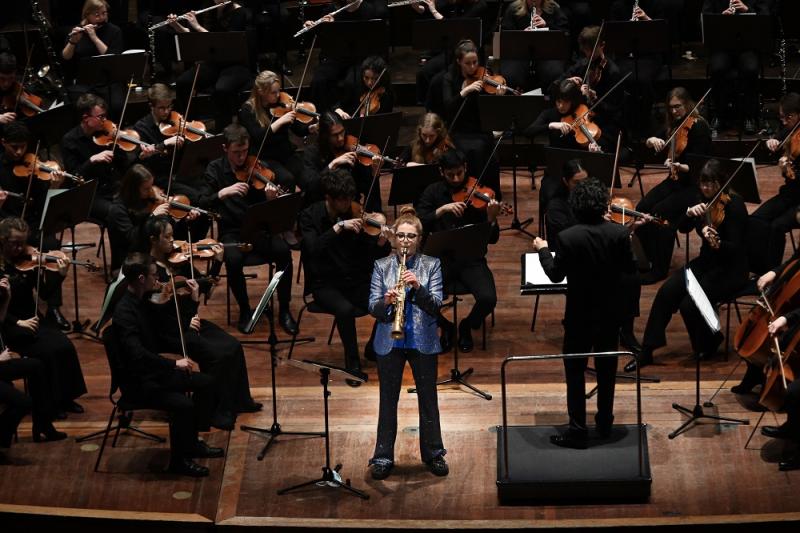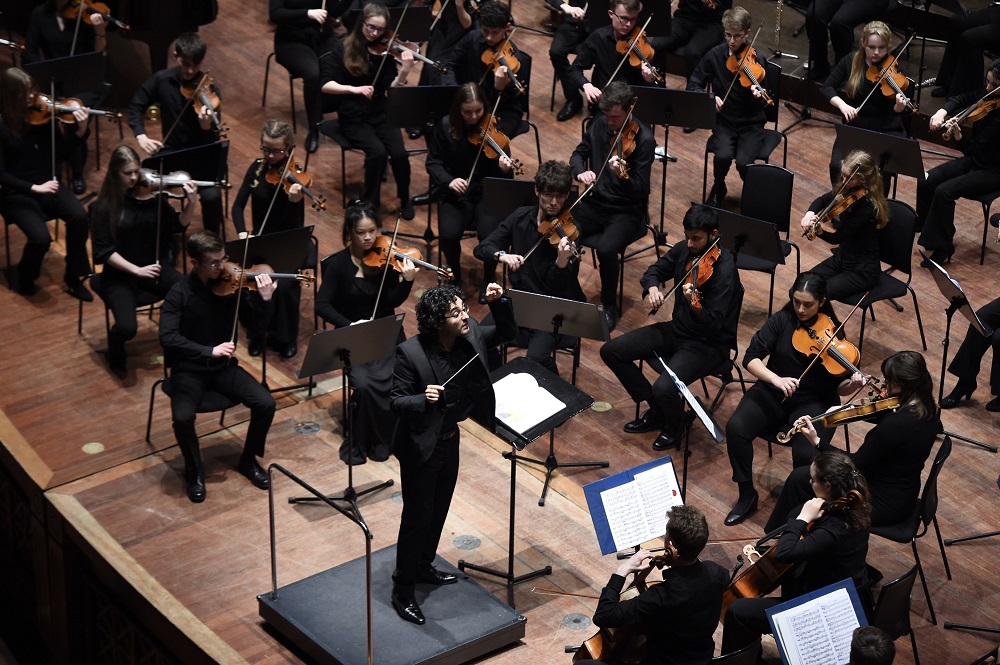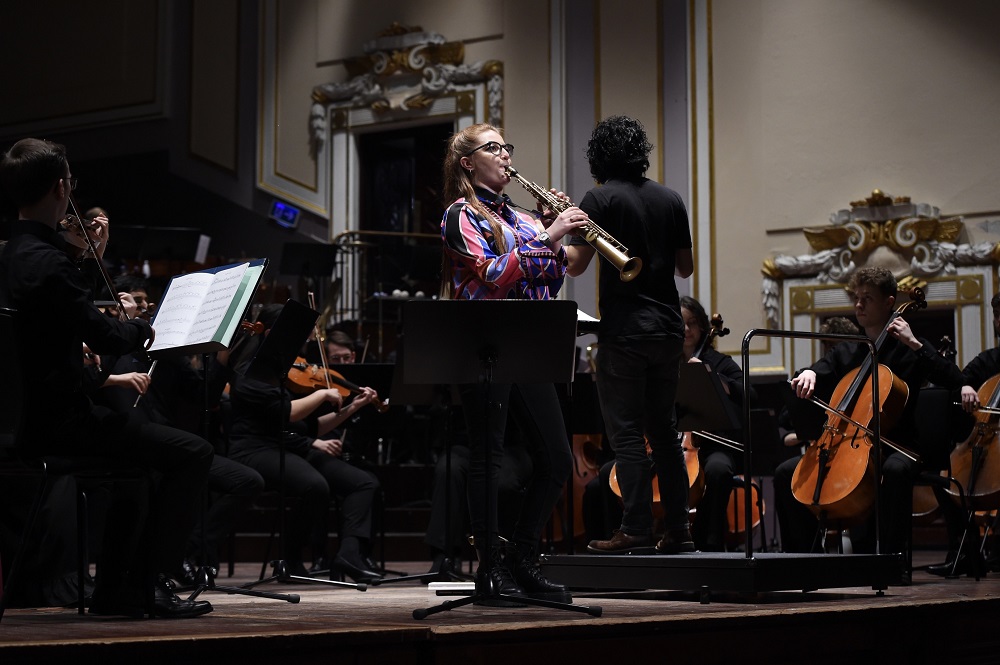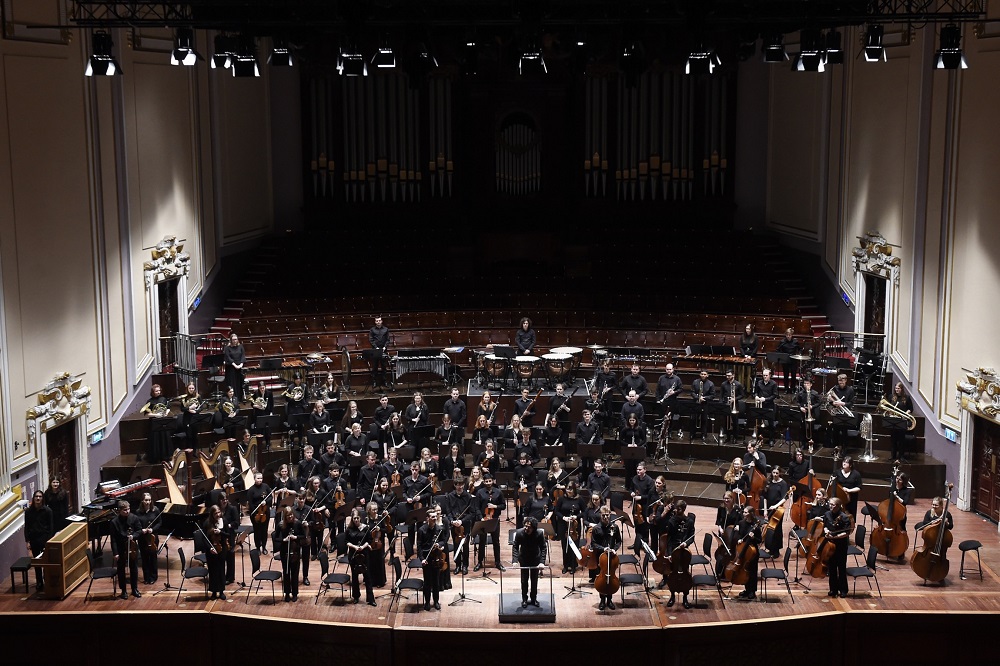Gillam, NYOS, Hasan, Usher Hall, Edinburgh - stunning variety from the new generation | reviews, news & interviews
Gillam, NYOS, Hasan, Usher Hall, Edinburgh - stunning variety from the new generation
Gillam, NYOS, Hasan, Usher Hall, Edinburgh - stunning variety from the new generation
Over 100 young people play at the highest level in Respighi, Harle and Shostakovich

I expected the National Youth Orchestra of Scotland’s Usher Hall concert to be jam-packed with a joyful melee of admiring friends and relatives. This is a vast orchestra of over 100, and it wouldn’t take that many aunts and uncles to fill the Usher’s cavernous spaces, but in the event the audience for this inspiring and diverse programme was disappointingly thin.
The lack of support did not diminish the quality of musicianship, which was very high indeed. In the (distant) past I can recall youth orchestras being defined by an unevenness of texture, typically bold brass and percussion tending to overwhelm a somewhat fragile string sound, but today’s NYOS could stand alongside any of the professional orchestras I have heard on this stage in recent history – of course it might help the volume a bit to have nearly 30 violins, three harps, six horns and five bassoons. It is certainly a big band.
The 30 year old British conductor Kerem Hasan chose music wisely to make best use of the large forces at his disposal, with the warm and colourful world of Respighi’s Rome and John Harle’s Briggflatts contrasting sharply with the bleached textures of Shostakovich’s Tenth Symphony in the second half.  We began with The Fountains of Rome, something of a virtuosic test piece for any orchestra, with diaphanous string textures conjuring up the break of day at the Fountain of Valle Giulia. I have always found Respighi to be more style than substance but this brightly lit performance did much to undermine my prejudices, with nicely judged brass, tolling bells, and a significant contribution from the celeste taking us on a journey to the Trevi Fountain and finally the Villa Medici, bringing these timeless Roman monuments to life.
We began with The Fountains of Rome, something of a virtuosic test piece for any orchestra, with diaphanous string textures conjuring up the break of day at the Fountain of Valle Giulia. I have always found Respighi to be more style than substance but this brightly lit performance did much to undermine my prejudices, with nicely judged brass, tolling bells, and a significant contribution from the celeste taking us on a journey to the Trevi Fountain and finally the Villa Medici, bringing these timeless Roman monuments to life.
Next, the undoubted star of the show was the young Cumbrian saxophonist Jess Gillam in the concerto Briggflatts by John Harle. This opens with an expansive flourish of notes from the soloist, the orchestra gradually finding its feet and settling to a lyrically jazzy accompaniment. The work is inspired by the eponymous poem by Basil Bunting and was written in 2019 for Jess Gillam, making the most of her nimble virtuosity and irrepressible personality. This too uses a huge orchestra, with a full battery of percussion, and it’s a tribute to both Gillam and her conductor that she remained clearly audible throughout.  Although somewhat clumsily expressed in the composer’s programme note, the concerto falls into three movements, “Flare”, “Garsdale” and “Rant!”, each with its own character. The first conveys a vivid sense of urgency, with African rhythms and at several points the entire orchestra clapping in unison. The soloist gives the impression of running in dizzy circles above and around a pulsating harmonic backcloth, which comes to an abrupt halt at the end of the movement as though falling off a cliff edge. There’s a brief respite in the slow movement that follows, before the final “Rant!” bounds into view with a distinct folk-like character, the soloist imitating the querulous sound of northern English bagpipes. A big tune (“The Ulverston Volunteers”) builds slowly into the orchestral fabric as the concerto pirouettes to its exultant conclusion. Words don’t really do this piece justice, but I can confidently say it was one of the most enjoyable and imaginative pieces of new music I have heard for a long time.
Although somewhat clumsily expressed in the composer’s programme note, the concerto falls into three movements, “Flare”, “Garsdale” and “Rant!”, each with its own character. The first conveys a vivid sense of urgency, with African rhythms and at several points the entire orchestra clapping in unison. The soloist gives the impression of running in dizzy circles above and around a pulsating harmonic backcloth, which comes to an abrupt halt at the end of the movement as though falling off a cliff edge. There’s a brief respite in the slow movement that follows, before the final “Rant!” bounds into view with a distinct folk-like character, the soloist imitating the querulous sound of northern English bagpipes. A big tune (“The Ulverston Volunteers”) builds slowly into the orchestral fabric as the concerto pirouettes to its exultant conclusion. Words don’t really do this piece justice, but I can confidently say it was one of the most enjoyable and imaginative pieces of new music I have heard for a long time.
It says something about the size of this orchestra that the forces required for Shostakovich’s Tenth Symphony were quite a lot diminished, with the three harps removed, no tubular bells, no piano. And this is a symphony whose famously unforgiving second movement aptly conveys the horrors of Stalin’s reign of terror. Indeed I can remember a blistering performance with the Royal Scottish National Orchestra under Neeme Jarvi in which Jarvi served up this vicious Allegro as an encore.  It seems almost unfair on such young players to ask them to conjure up the atmosphere in Russia in 1953, with the uneasy truce following Stalin’s death, except that now we have a new terror on the block and our young people are those that will pay the price for Putin’s political folly for generations to come. This was a hard, bleak, but confident performance that pulled Shostakovich’s many strands of musical argument, from the two note Stalin motif to his own haunting DSCH signature, into a coherent whole. Towards the end, after a brief resurgence of the Allegro, the four notes of DSCH seem to drop into the orchestra texture like tiny pebbles into a clear pond, only to build confidently into a grand climax, the triumph of the personal over the state. Some hope, maybe. The small audience whooped and cheered, enthusiasm going some way to compensate for lack of numbers.
It seems almost unfair on such young players to ask them to conjure up the atmosphere in Russia in 1953, with the uneasy truce following Stalin’s death, except that now we have a new terror on the block and our young people are those that will pay the price for Putin’s political folly for generations to come. This was a hard, bleak, but confident performance that pulled Shostakovich’s many strands of musical argument, from the two note Stalin motif to his own haunting DSCH signature, into a coherent whole. Towards the end, after a brief resurgence of the Allegro, the four notes of DSCH seem to drop into the orchestra texture like tiny pebbles into a clear pond, only to build confidently into a grand climax, the triumph of the personal over the state. Some hope, maybe. The small audience whooped and cheered, enthusiasm going some way to compensate for lack of numbers.
rating
Explore topics
Share this article
The future of Arts Journalism
You can stop theartsdesk.com closing!
We urgently need financing to survive. Our fundraising drive has thus far raised £49,000 but we need to reach £100,000 or we will be forced to close. Please contribute here: https://gofund.me/c3f6033d
And if you can forward this information to anyone who might assist, we’d be grateful.

Subscribe to theartsdesk.com
Thank you for continuing to read our work on theartsdesk.com. For unlimited access to every article in its entirety, including our archive of more than 15,000 pieces, we're asking for £5 per month or £40 per year. We feel it's a very good deal, and hope you do too.
To take a subscription now simply click here.
And if you're looking for that extra gift for a friend or family member, why not treat them to a theartsdesk.com gift subscription?
more Classical music
 Kempf, Brno Philharmonic, Davies, Bridgewater Hall, Manchester review - European tradition meets American jazz
Bouncing Czechs enjoy their Gershwin and Brubeck alongside Janáček and Dvořák
Kempf, Brno Philharmonic, Davies, Bridgewater Hall, Manchester review - European tradition meets American jazz
Bouncing Czechs enjoy their Gershwin and Brubeck alongside Janáček and Dvořák
 Solomon, OAE, Butt, QEH review - daft Biblical whitewashing with great choruses
Even a top soprano and mezzo can’t make this Handel paean wholly convincing
Solomon, OAE, Butt, QEH review - daft Biblical whitewashing with great choruses
Even a top soprano and mezzo can’t make this Handel paean wholly convincing
 Two-Piano Gala, Kings Place review - shining constellations
London Piano Festival curators and illustrious friends entertain and enlighten
Two-Piano Gala, Kings Place review - shining constellations
London Piano Festival curators and illustrious friends entertain and enlighten
 Echo Vocal Ensemble, Latto, Union Chapel review - eclectic choral programme garlanded with dance
Beautiful singing at the heart of an imaginative and stylistically varied concert
Echo Vocal Ensemble, Latto, Union Chapel review - eclectic choral programme garlanded with dance
Beautiful singing at the heart of an imaginative and stylistically varied concert
 Scott, Irish Baroque Orchestra, Whelan, RIAM, Dublin review - towards a Mozart masterpiece
Characteristic joy and enlightenment from this team, but a valveless horn brings problems
Scott, Irish Baroque Orchestra, Whelan, RIAM, Dublin review - towards a Mozart masterpiece
Characteristic joy and enlightenment from this team, but a valveless horn brings problems
 Classical CDs: Voice flutes, flugelhorns and froth
Baroque sonatas, English orchestral music and an emotionally-charged vocal recital
Classical CDs: Voice flutes, flugelhorns and froth
Baroque sonatas, English orchestral music and an emotionally-charged vocal recital
 Kanneh-Mason, Britten Sinfonia, Shave, Milton Court - a grin and a big beaming smile
A pair of striking contemporary pieces alongside two old favourites
Kanneh-Mason, Britten Sinfonia, Shave, Milton Court - a grin and a big beaming smile
A pair of striking contemporary pieces alongside two old favourites
 theartsdesk at the New Ross Piano Festival - Finghin Collins’ musical rainbow
From revelatory Bach played with astounding maturity by a 22 year old to four-hand jazz
theartsdesk at the New Ross Piano Festival - Finghin Collins’ musical rainbow
From revelatory Bach played with astounding maturity by a 22 year old to four-hand jazz
 First Person: Manchester Camerata's Head of Artistic Planning Clara Marshall Cawley on questioning the status quo
Five days of free events with all sorts of audiences around Manchester starts tomorrow
First Person: Manchester Camerata's Head of Artistic Planning Clara Marshall Cawley on questioning the status quo
Five days of free events with all sorts of audiences around Manchester starts tomorrow
 Goldscheider, Brother Tree Sound, Kings Place review - music of hope from a young composer
Unusual combination of horn, strings and electronics makes for some intriguing listening
Goldscheider, Brother Tree Sound, Kings Place review - music of hope from a young composer
Unusual combination of horn, strings and electronics makes for some intriguing listening

Add comment